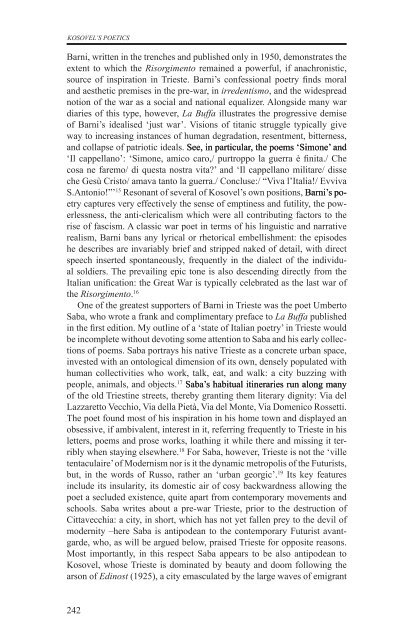razprave (pdf) - Društvo za primerjalno književnost - ZRC SAZU
razprave (pdf) - Društvo za primerjalno književnost - ZRC SAZU
razprave (pdf) - Društvo za primerjalno književnost - ZRC SAZU
- No tags were found...
Create successful ePaper yourself
Turn your PDF publications into a flip-book with our unique Google optimized e-Paper software.
KOSOVEL’s poeticsBarni, written in the trenches and published only in 1950, demonstrates theextent to which the Risorgimento remained a powerful, if anachronistic,source of inspiration in Trieste. Barni’s confessional poetry finds moraland aesthetic premises in the pre-war, in irredentismo, and the widespreadnotion of the war as a social and national equalizer. Alongside many wardiaries of this type, however, La Buffa illustrates the progressive demiseof Barni’s idealised ‘just war’. Visions of titanic struggle typically giveway to increasing instances of human degradation, resentment, bitterness,and collapse of patriotic ideals. See, in particular, the poems ‘Simone’ and‘Il cappellano’: ‘Simone, amico caro,/ purtroppo la guerra è finita./ Checosa ne faremo/ di questa nostra vita?’ and ‘Il cappellano militare/ disseche Gesù Cristo/ amava tanto la guerra./ Concluse:/ “Viva l’Italia!/ EvvivaS.Antonio!”’ 15 Resonant of several of Kosovel’s own positions, Barni’s poetrycaptures very effectively the sense of emptiness and futility, the powerlessness,the anti-clericalism which were all contributing factors to therise of fascism. A classic war poet in terms of his linguistic and narrativerealism, Barni bans any lyrical or rhetorical embellishment: the episodeshe describes are invariably brief and stripped naked of detail, with directspeech inserted spontaneously, frequently in the dialect of the individualsoldiers. The prevailing epic tone is also descending directly from theItalian unification: the Great War is typically celebrated as the last war ofthe Risorgimento. 16One of the greatest supporters of Barni in Trieste was the poet UmbertoSaba, who wrote a frank and complimentary preface to La Buffa publishedin the first edition. My outline of a ‘state of Italian poetry’ in Trieste wouldbe incomplete without devoting some attention to Saba and his early collectionsof poems. Saba portrays his native Trieste as a concrete urban space,invested with an ontological dimension of its own, densely populated withhuman collectivities who work, talk, eat, and walk: a city buzzing withpeople, animals, and objects. 17 Saba’s habitual itineraries run along manyof the old Triestine streets, thereby granting them literary dignity: Via delLaz<strong>za</strong>retto Vecchio, Via della Pietà, Via del Monte, Via Domenico Rossetti.The poet found most of his inspiration in his home town and displayed anobsessive, if ambivalent, interest in it, referring frequently to Trieste in hisletters, poems and prose works, loathing it while there and missing it terriblywhen staying elsewhere. 18 For Saba, however, Trieste is not the ‘villetentaculaire’ of Modernism nor is it the dynamic metropolis of the Futurists,but, in the words of Russo, rather an ‘urban georgic’. 19 Its key featuresinclude its insularity, its domestic air of cosy backwardness allowing thepoet a secluded existence, quite apart from contemporary movements andschools. Saba writes about a pre-war Trieste, prior to the destruction ofCittavecchia: a city, in short, which has not yet fallen prey to the devil ofmodernity –here Saba is antipodean to the contemporary Futurist avantgarde,who, as will be argued below, praised Trieste for opposite reasons.Most importantly, in this respect Saba appears to be also antipodean toKosovel, whose Trieste is dominated by beauty and doom following thearson of Edinost (1925), a city emasculated by the large waves of emigrant242
















